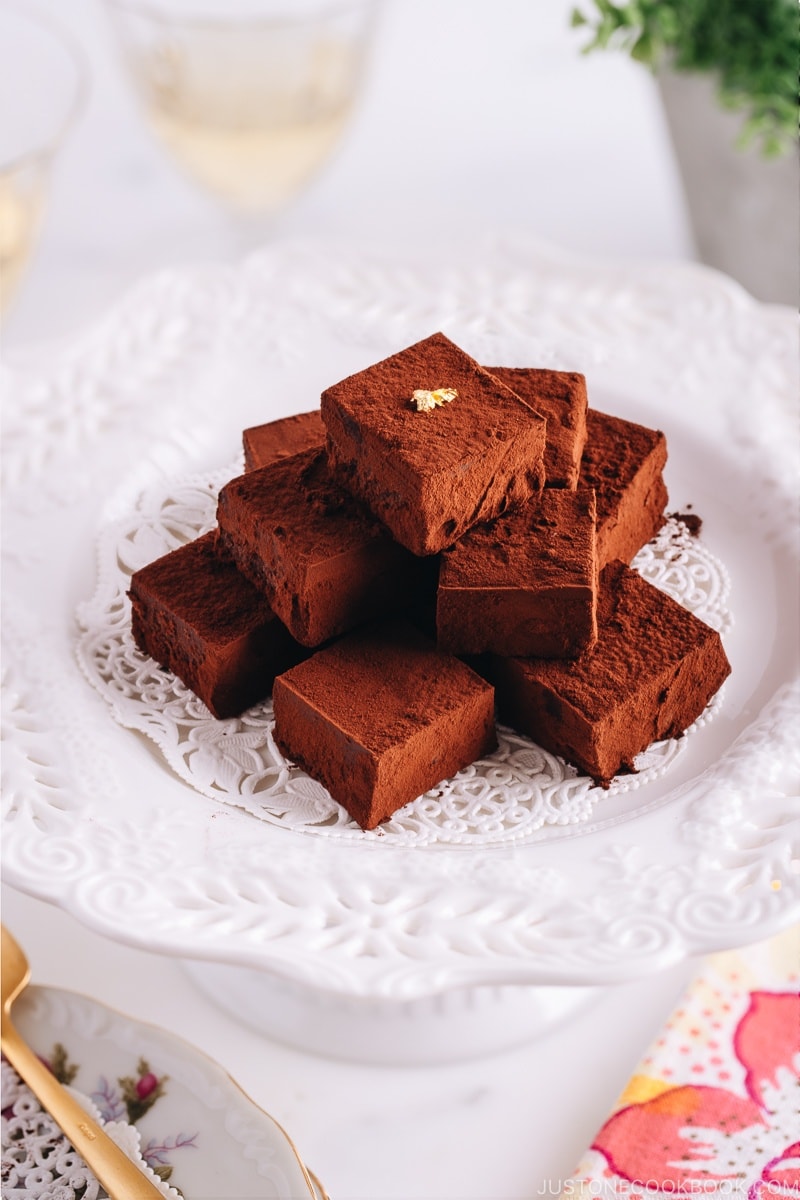
If you are a frequent visitor to Japan, you probably have heard of or tasted this Japanese chocolate called Nama Chocolate (生チョコレート). You can’t really avoid it at the airport gift shops. They come in fancy packaging that makes them a popular gift item to bring home from Japan.
Nama Chocolate is rich, smooth, and moist, with a silky texture that practically melts in your mouth. The good news is you don’t have to fly to Japan to enjoy the luxurious sweet. With this recipe, you can make your chocolate dream come true today!
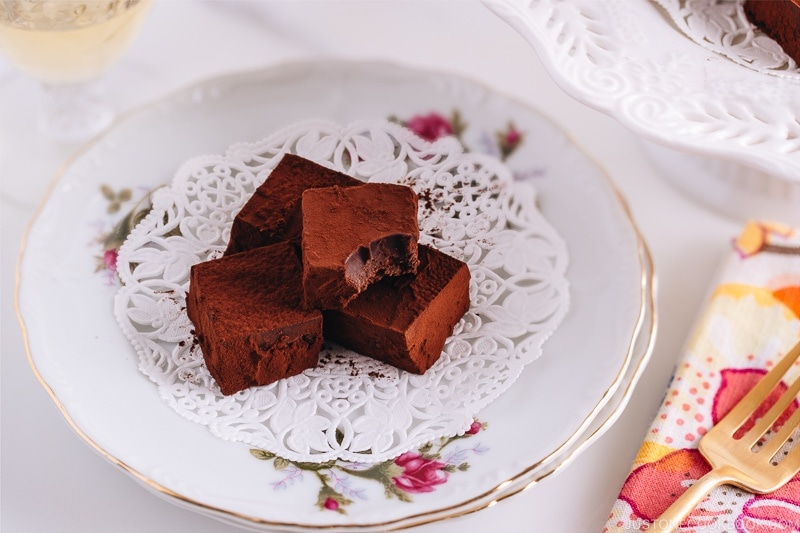
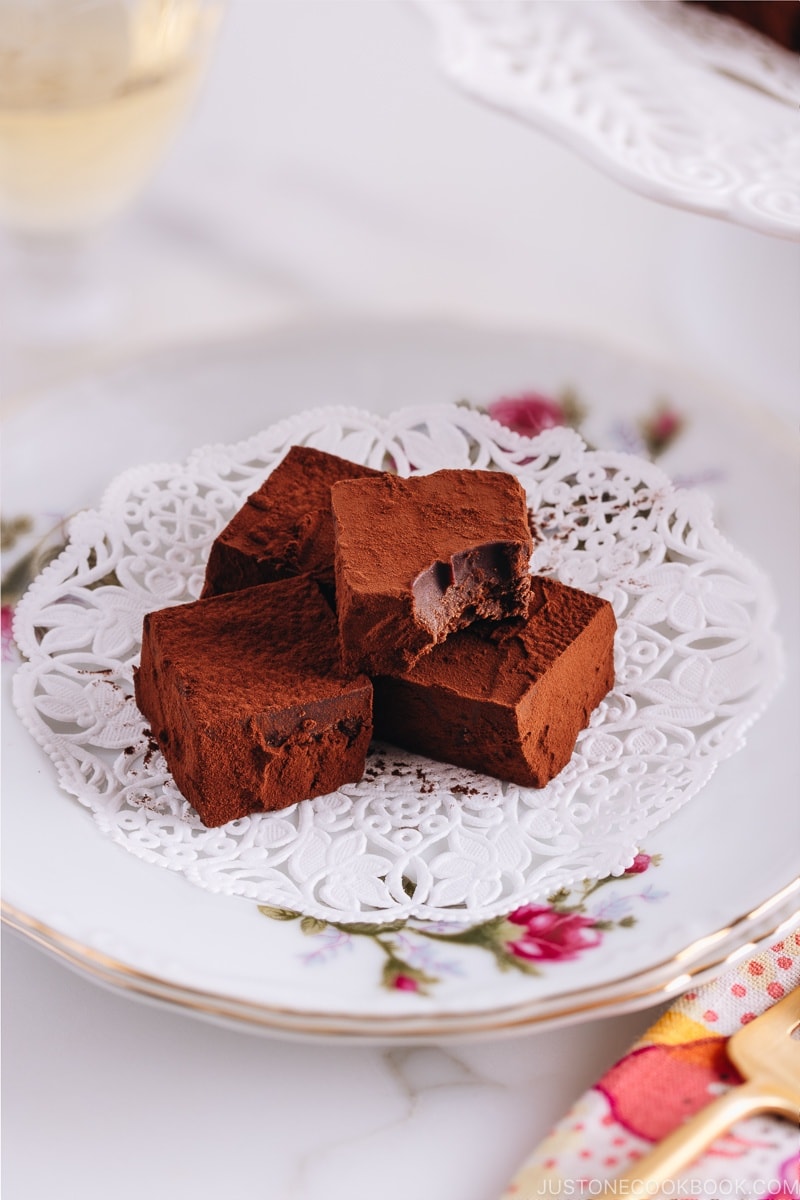
What is Nama Chocolate?
Nama Chocolate is a form of chocolate ganache, similar to the filling inside French truffles. It’s made of fresh cream and chocolate, cut into little cubes, and dusted with fine cocoa powder.
We can only call it “Nama Chocolate” when it contains at least 40% chocolate and 10% cream by weight, and no more than 10% water.
Nama Chocolate is much easier to prepare than chocolate truffles because the chocolate mixture is poured into a square pan, chilled until firm, then cut into mini squares. No messy hands since there’s no rolling required, but it has the same decadent chocolate flavor.
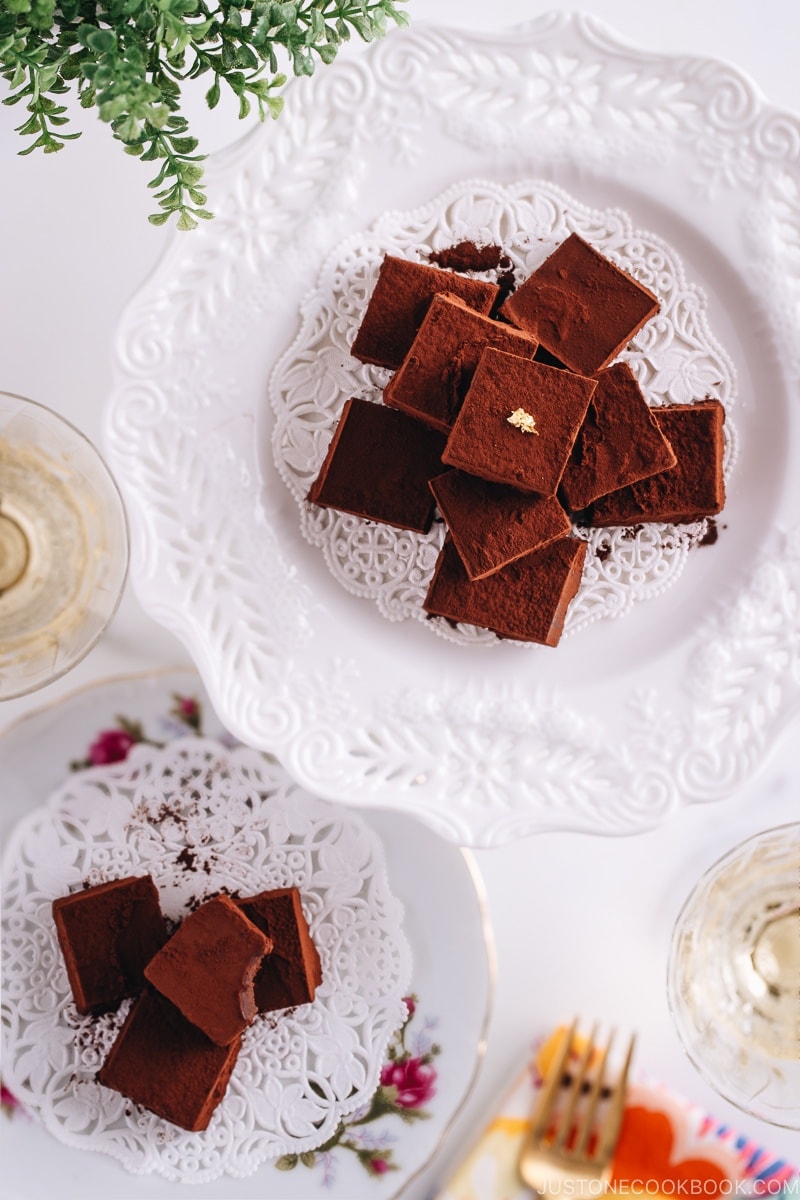
What Does Nama Mean?
Nama (生, pronounce [na-ma]) means raw or fresh in Japanese. The name Nama Chocolate refers to the plentiful use of rich, fresh cream in the chocolate.
Because of the fresh cream, we must refrigerate Nama Chocolate at all times and enjoy them within 4 days of making them. You can also keep in the freezer for up to a month.
If you’re planning to give Nama Chocolate as a gift, make sure to let the gift receiver know to consume soon.
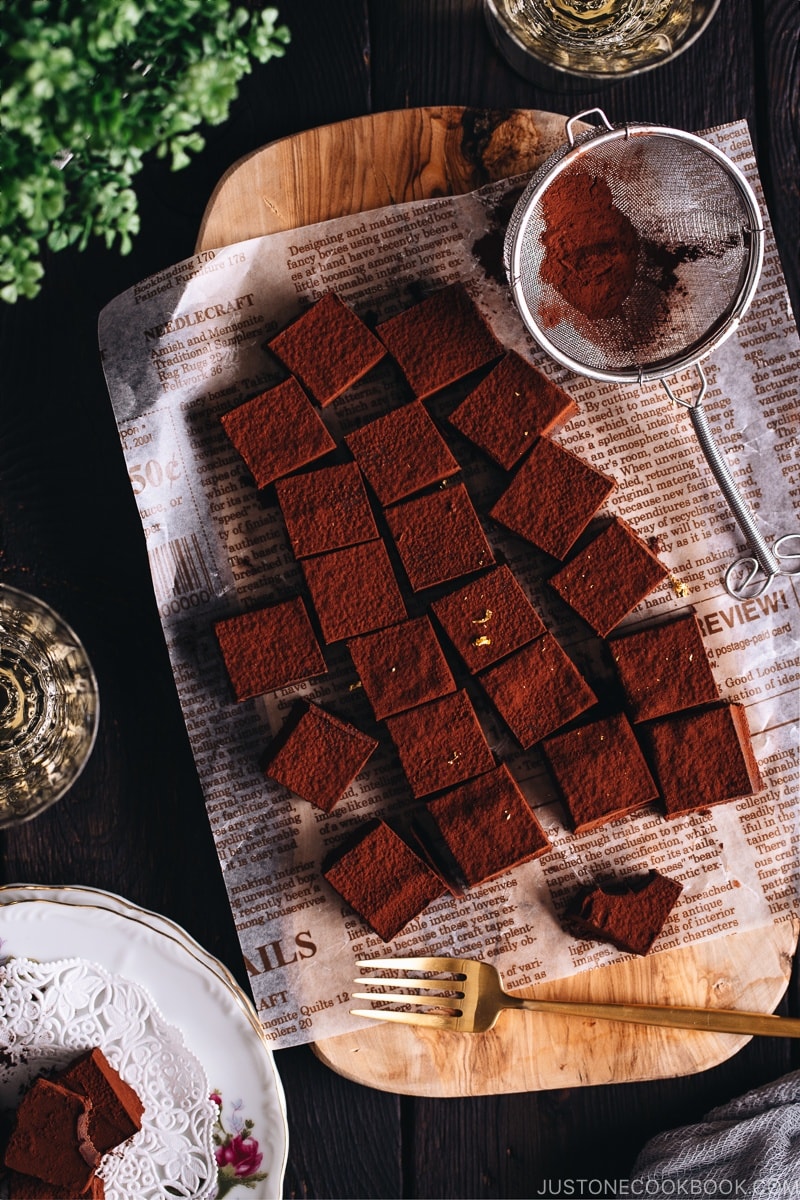
History of Nama Chocolate
In 1988, the owner and chef Masakazu Kobayashi at the sweet shop Sils Maria created a new type of chocolate, and he named this chocolate Nama Chocolate and Nama Choco (生チョコ) for short.
In 1993, Meiji, a snack company, released a chocolate product called Meltykiss (メルティーキッス) which was produced and supervised by chef Kobayashi. You can purchase a box of Meltykiss at Asian supermarkets, convenience stores, and train kiosks in Japan. This chocolate is known for its limited-time offering during the winter months as the chocolate melts quickly during the rest of the seasons.
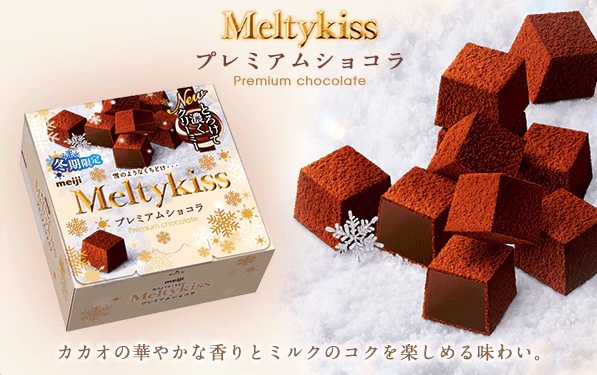
Since then, major confectionery manufacturers started to sell Nama Chocolate, and it became a huge trend all over the country.
In 1996, Hokkaido-based ROYCE’ (ロイズ) released ROYCE’ Nama Chocolate. Many of you probably spotted this chocolate at the airports or gift shops at sightseeing spots in Japan. Due to their popularity, this Nama Chocolate is known to visitors who have been to Japan.
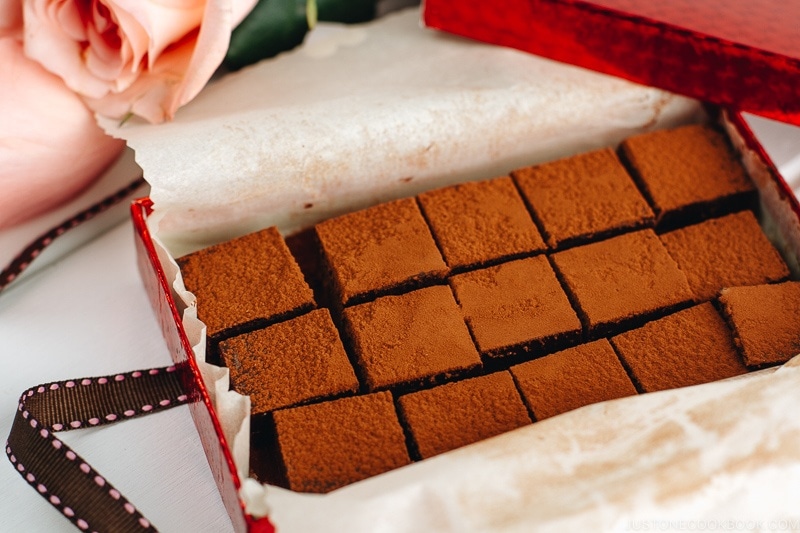
Although “Nama Chocolate” was invented in Japan in the late ’80s, this specific type of chocolate called “Pave de Geneva” was born in Geneva, Switzerland in 1930s. Pave de Geneva is made of chocolate and fresh cream and cut into small cubes smeared with cocoa, just like Nama Chocolate.
I’m not sure whether the Japanese chef had traveled to Geneva and knew of Pave de Geneva, or he figured out the Nama Chocolate formula on his own. Regardless, this is not an original Japanese product as it existed in Switzerland.
If you’re a Genevan who tried both Pave de Geneva and Nama Chocolate, please share your thoughts in the comments below. Are they similar or exactly the same?
Ingredients You’ll Need
You only need three ingredients (and four with the optional liqueur) for this ROYCE’ copycat recipe.
- dark chocolate (70% cacao) – choose a good-quality product; use semisweet chocolate if you prefer a less bitter taste
- heavy (whipping) cream – use cream with 36% milkfat
- liqueur of your choice – optional, to taste; I use brandy
- Dutch-process cocoa powder – to dust on the chocolate squares; you can buy it on Amazon
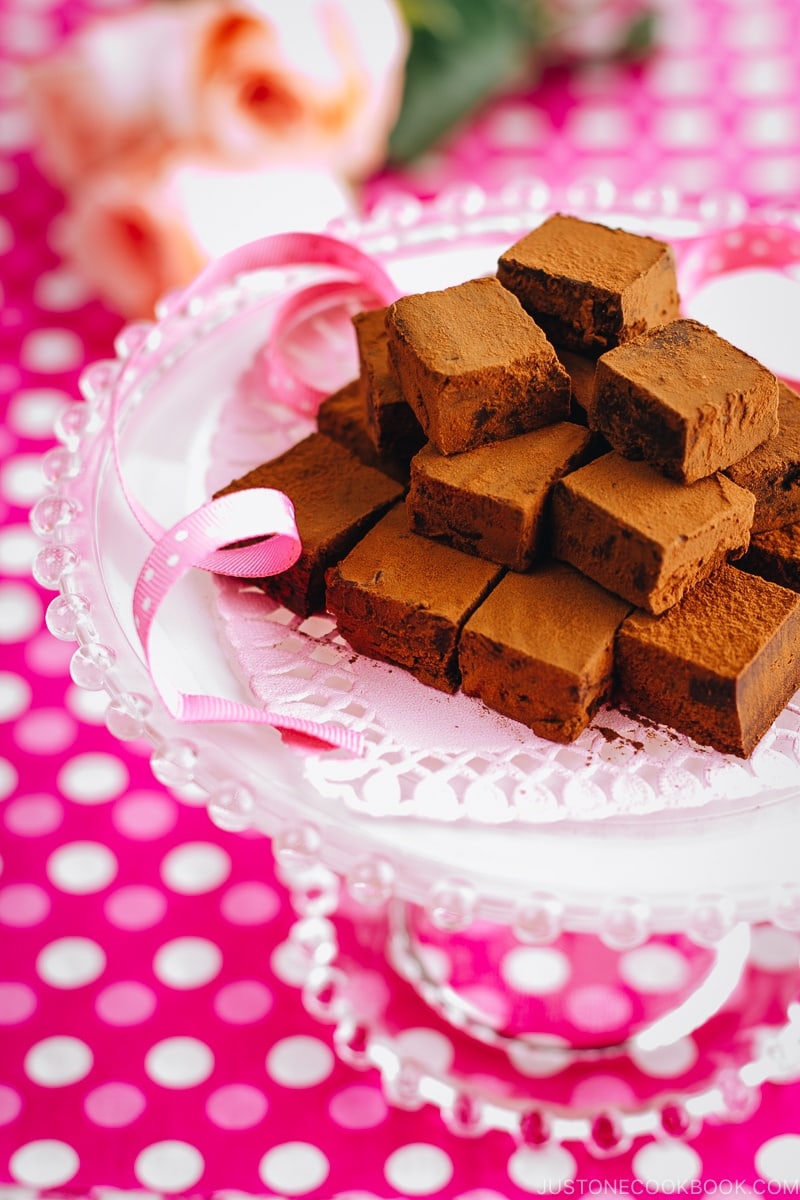
How to Make Nama Chocolate
Here’s a brief overview of how to make this sweet treat; see the recipe card below for the complete instructions.
- Chop the dark chocolate bar (or block of chocolate) into smaller pieces with a sharp knife.
- Line a square baking dish with parchment paper.
- Heat the cream in a small saucepan over medium heat on the stove. Do not boil. When you see small bubbles form around the edges of the saucepan, remove it from the heat.
- Add the chocolate pieces into the cream and stir with a silicone spatula to combine. Mix until the chocolate is melted and there are no more lumps. Add the optional liqueur and stir.
- Pour the smooth chocolate mixture into the prepared baking dish. Chill in the fridge for several hours until firm.
- Cut into squares with a sharp knife run under warm or hot water and wiped dry with a kitchen towel. Dust with cocoa powder.
Keep the Nama Chocolate refrigerated until ready to serve. Let it sit at room temperature for 5–10 minutes beforehand so it‘s soft enough to melt in your mouth.
The prep time plus cook time is 30 minutes, but with 4 hours of chilling time, the total time for this recipe is 4.5 hours.
Tips for Making Nama Chocolate
1. Use Good Chocolate
High-quality chocolate is mandatory since that’s the most important ingredient for making delicious Nama Chocolate. Make sure the chocolate is made of 100% cocoa butter and does not include vegetable fat in the ingredient list.
2. Use Heavy Cream
American heavy cream or heavy whipping cream (they are the same thing) has a 36–38% fat content. The ratio of heavy (whipping) cream (gram/ml) and chocolate (gram) should be 1:2.
3. Dry and Clean Utensils
Make sure the bowls and utensils you are using are perfectly dry. Even a small amount of water/steam can “seize” the chocolate melting process. It can happen all of the sudden from a smooth bowl of liquid chocolate to a lumpy, grainy mass of chocolate.
4. Do Not Substitute White Chocolate
For this recipe, please do not replace chocolate with white chocolate. For a white chocolate version, you can make my matcha Green Tea Nama Chocolate recipe, which includes unsalted butter as an additional ingredient.
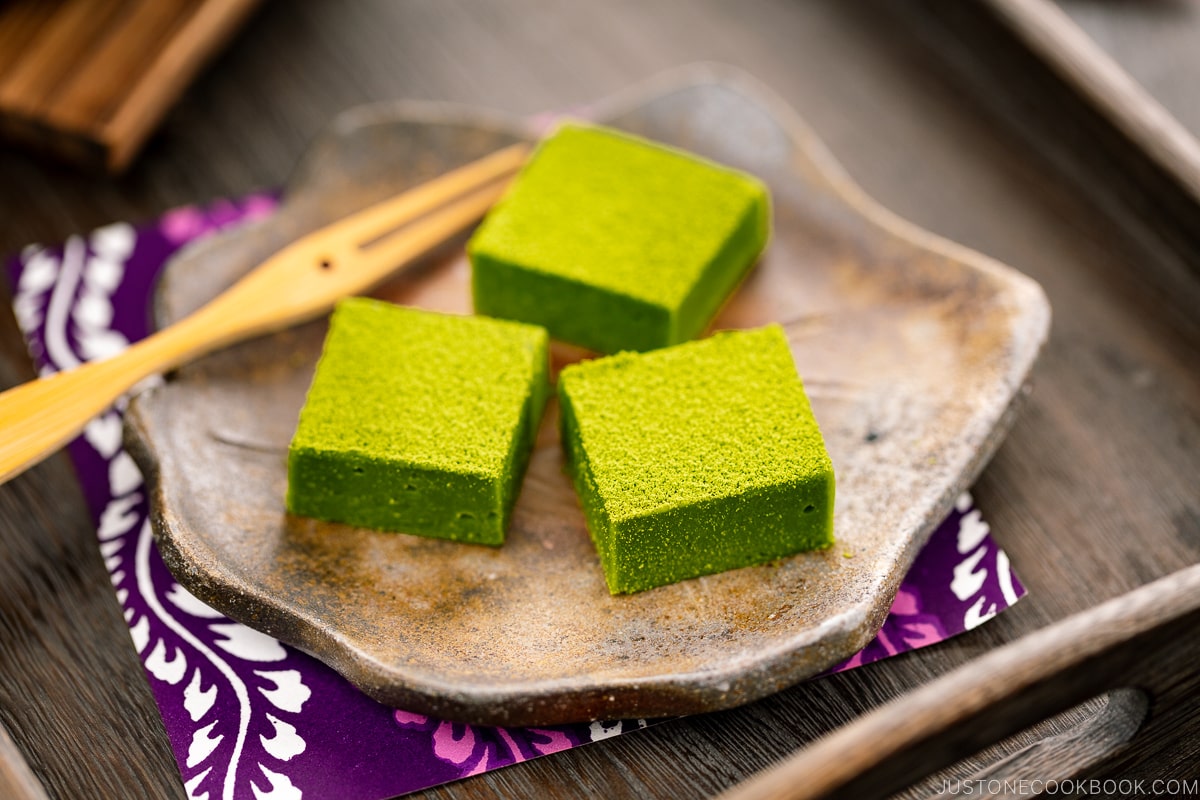
FAQs
Why did my chocolate release oil?
Separation (when oil comes out of the chocolate) happens when you get the chocolate too hot. Never heat dark chocolate above 120ºF (49ºC) and never heat milk chocolate and white chocolate above 110ºF (43ºC). When chocolate gets too hot, the cocoa butter separates from the solids, and there is no way to salvage it (although you can bake with it and it tastes fine).
The best way to prevent separation is to stir the mixture frequently. Since we’re not using a double boiler in this recipe, make sure you do not bring the mixture to a full boil. Remove from the heat as soon as you see bubbles around the edges of the saucepan.
Why did my chocolate seize?
Seizing happens when moisture is introduced to melted chocolate, even a tiny amount of liquid or steam. When this happens, a smooth bowl of liquid chocolate can suddenly become a lumpy, grainy mass. To prevent this, make sure the bowls and utensils that you are using are perfectly dry.
Can I use white chocolate in this recipe?
Please do not replace the chocolate with white chocolate for this recipe. The ratio of heavy cream to chocolate is not the same as this recipe. If you want to make a white chocolate version, see my Matcha Chocolate recipe.
Other Chocolate Recipes You’ll Love
These chocolate goodies and desserts are perfect for special occasions or as a hostess gift during the holiday season. I hope you enjoy making this Nama Chocolate recipe!
- Chocolate Gateau (Chocolate Cake)
- Frozen Chocolate Banana
- Chocolate Covered Strawberries
- Chocolate Almond Toffee
- Chocolate Chiffon Cake
- Matcha Gateau au Chocolat
- Chocolate Chip Cookies with Nutella
- Valentine’s Day Chocolate Recipes
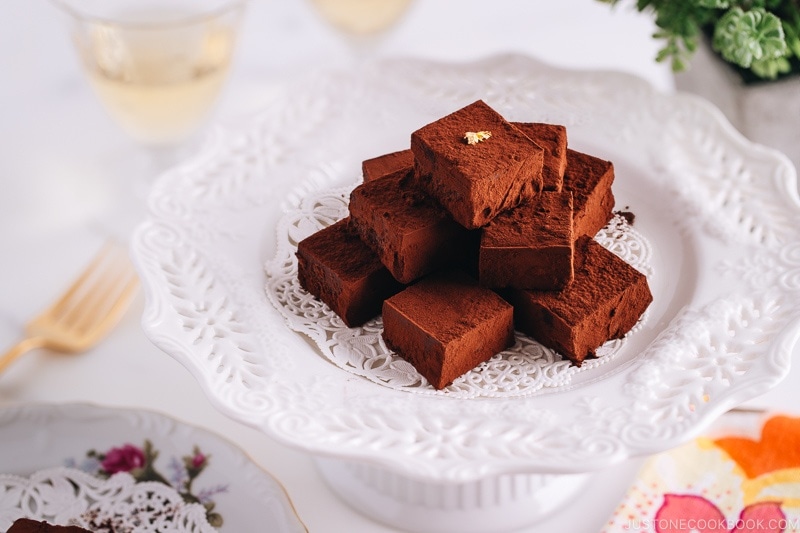
Wish to learn more about Japanese cooking? Sign up for our free newsletter to receive cooking tips & recipe updates! And stay in touch with me on Facebook, Pinterest, YouTube, and Instagram.
Nama Chocolate
Ingredients
- 14 oz good-quality dark chocolate (70% cacao) (use semisweet chocolate if you prefer a less bitter taste)
- 200 ml heavy (whipping) cream (¾ cup + 4 tsp; 36% milkfat)
- 1 Tbsp liqueur of your choice (optional, to taste; I use brandy)
- Dutch-process cocoa powder (to coat the chocolate; you can buy it on Amazon)
Instructions
Before You Start…
- Please note that this recipe requires a chilling time of 4 hours. Also, read the Notes section at the end of this recipe card for important tips to successfully make this Nama Chocolate.
- Gather all the ingredients.
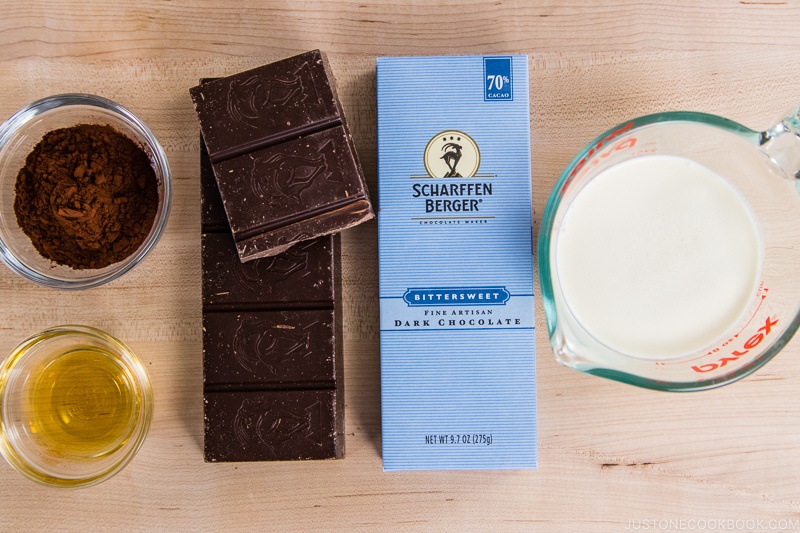
To Prepare the Nama Chocolate
- With a sharp knife, chop 14 oz good-quality dark chocolate (70% cacao) into smaller pieces so that they will melt faster and more evenly.
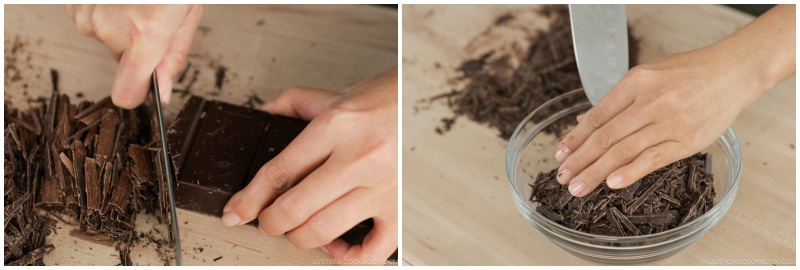
- Line an 8- x 8-inch (20- x 20-cm) baking dish with parchment paper. Tip: To make the chocolate the correct height, it‘s important to choose a dish or tray that‘s the right size; if you use a bigger tray, the chocolate will be flatter.
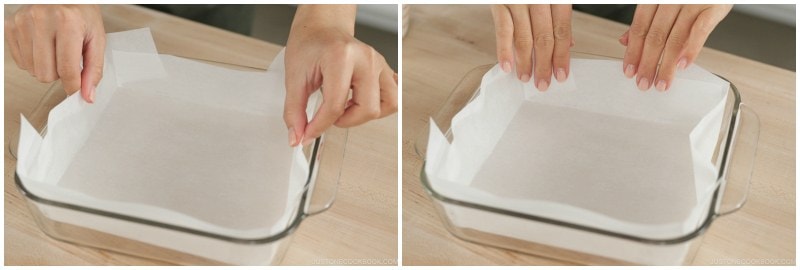
- Add 200 ml heavy (whipping) cream (¾ cup + 4 tsp) into a small saucepan over medium heat. Heat the cream to ALMOST a boil. Whisk lightly to evenly distribute the heat. Keep an eye on the cream to make sure it doesn‘t boil. Tip: Overheating the cream may cause the chocolate to separate in the next step (see Notes below for more information).
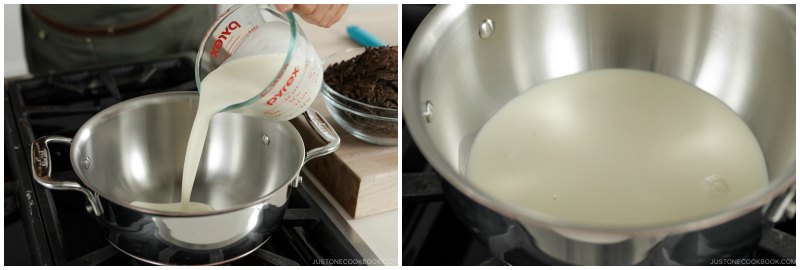
- When you see small bubbles form around the edges of the saucepan, remove it from the heat.
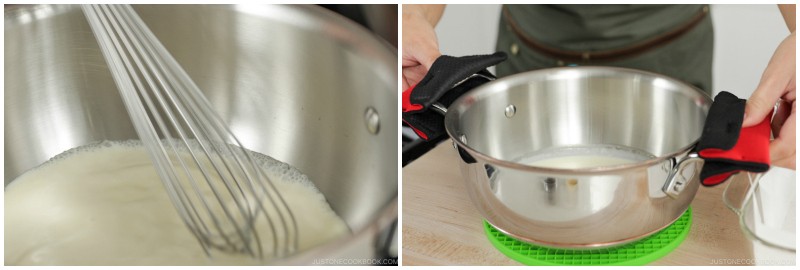
- Next, add the chocolate pieces into the cream and stir with a silicone spatula to combine. Tip: Make sure your utensil is completely dry; introducing even a tiny amount of water or steam may cause the melted chocolate to seize (see Notes below for more details).
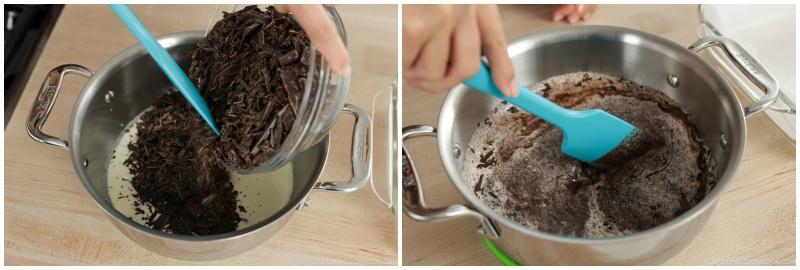
- Mix until the chocolate is melted and there are no more lumps. The chocolate and cream mixture should be completely smooth.
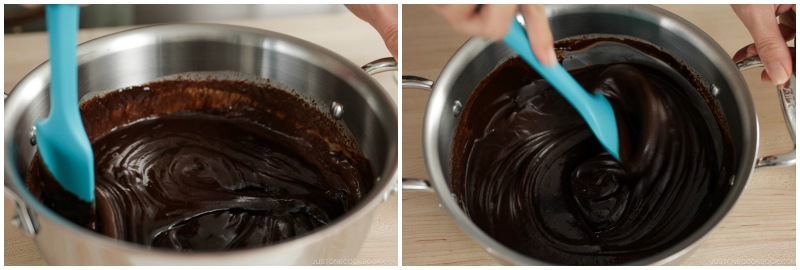
- If you‘d like, add 1 Tbsp liqueur of your choice (optional), and stir to incorporate.
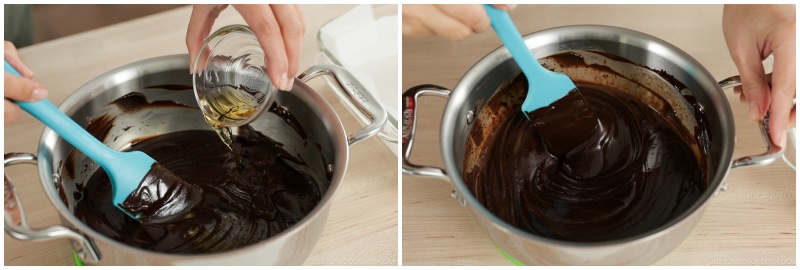
- Pour the mixture into the prepared baking dish and smooth the surface with the silicone spatula.
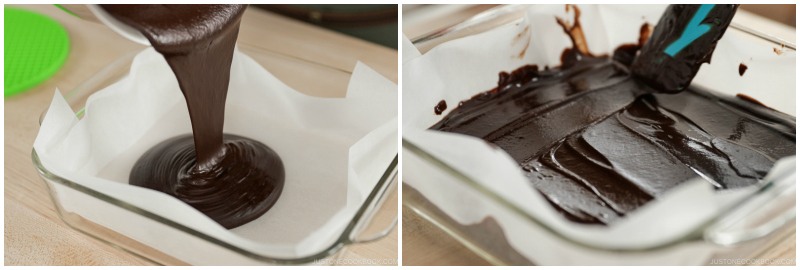
- Tap the baking dish onto the counter a few times to make sure the chocolate is evenly distributed. Refrigerate until firm, about 4–5 hours.
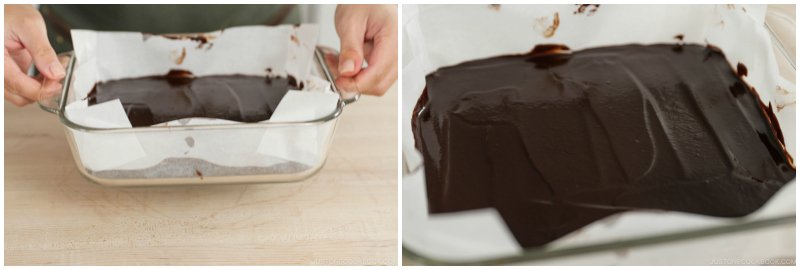
To Cut the Chocolate
- After chilling for 4–5 hours, remove the chocolate with its parchment paper from the baking dish. Peel away the parchment paper from the sides.
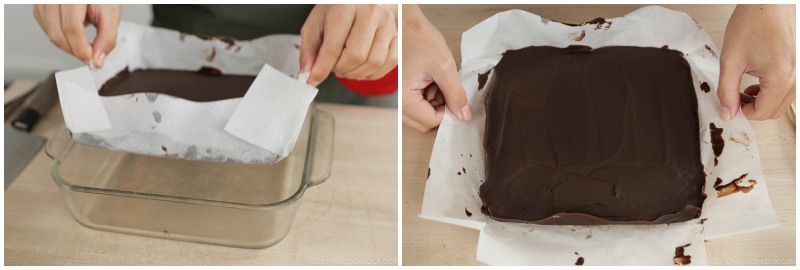
- With a sharp knife, cut off the stray pieces of excess chocolate around the four sides to make sharp corners and edges.
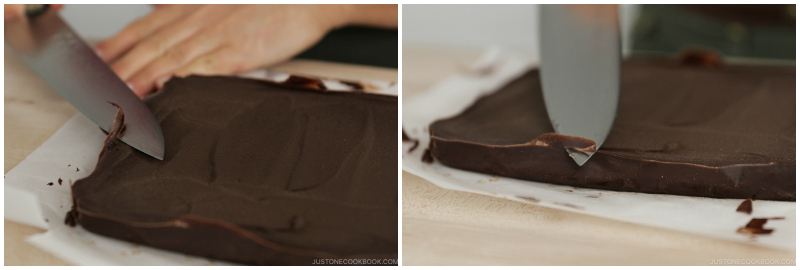
- Warm up the knife with a hot towel. Then, cut the chocolate slab into 1-inch (2.5-cm) strips. Make sure to clean and warm the knife before each cut to achieve a nice sharp cut.
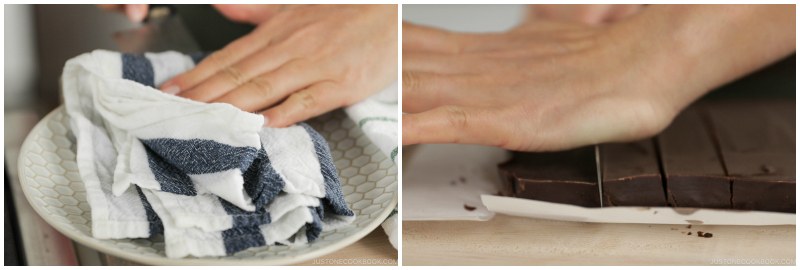
- If your baking dish has curved edges and corners like mine, the edge strips may not be the ideal shape for cutting into neat chocolate cubes. If that‘s the case, cut off and save these chocolate pieces for yourself to enjoy.
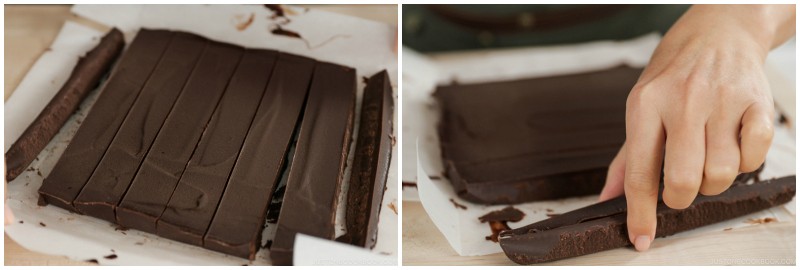
- Next, cut the strips into cubes. Remember to clean and warm up the knife before each cut.
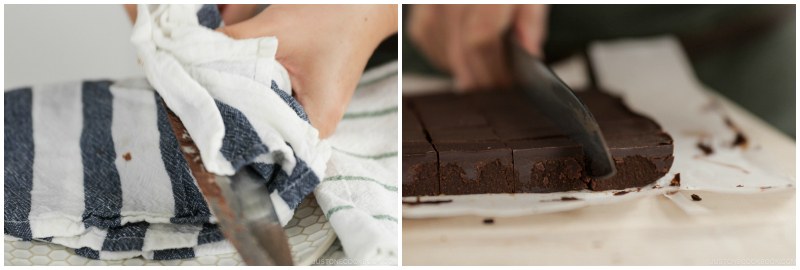
- Using a sugar duster or fine-mesh sieve, sprinkle the cubes on top with Dutch-process cocoa powder. Optionally, if you prefer the powder to completely cover the chocolate, you can dip each piece in the cocoa powder to coat all sides.
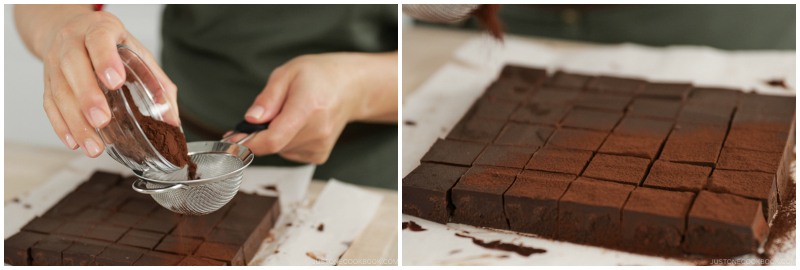
To Serve
- Keep the Nama Chocolate refrigerated. Serve it on a plate, or put it in a box as a gift. I recommend letting the chilled and firm chocolate sit at room temperature for 5–10 minutes before serving so it‘s soft enough to melt in your mouth.
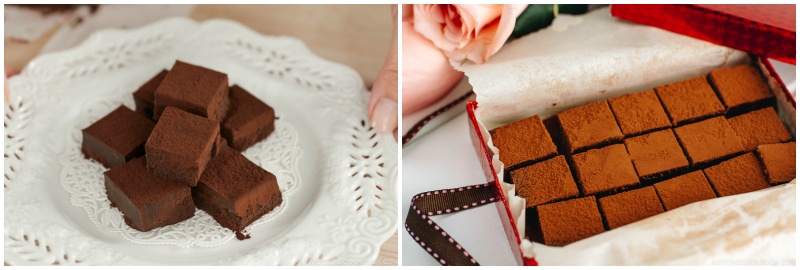
To Store
- Keep in an airtight container and store in the refrigerator for up to 4 days or in the freezer for up to a month.
Notes
- Separation (when oil comes out of the chocolate) happens when you get the chocolate too hot. Never heat dark chocolate above 120ºF (49ºC) and never heat milk chocolate and white chocolate above 110ºF (43ºC). When chocolate gets too hot, the cocoa butter separates from the solids, and there is no way to salvage it (although you can bake with it and it tastes fine). The best way to prevent separation is to stir the mixture frequently. Since we’re not using a double boiler in this recipe, make sure you do not bring the mixture to a full boil. Remove from the heat as soon as you see bubbles around the edges of the saucepan.
- Seizing happens when moisture is introduced to melted chocolate, even a tiny amount of liquid or steam. When this happens, a smooth bowl of liquid chocolate can suddenly become a lumpy, grainy mass. To prevent this, make sure the bowls and utensils that you are using are perfectly dry.
- To learn more details and how to fix overheated or seized chocolate, please read here.
- The ratio of heavy whipping cream and chocolate should be 1:2. Please do not replace the chocolate with white chocolate for this recipe. The ratio is not the same.
Nutrition
Did you make this recipe?
Tag @justonecookbook on Instagram so we can see your delicious creation!
Editor’s Note: The post was originally published on February 6, 2012. The content has been updated.



